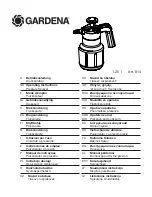
6.
Remove the dipstick and check the oil level in
the engine (
).
g195187
Figure 73
1.
Low
3.
High
2.
Full
4.
Dipstick
7.
Slowly add additional specified oil to bring the oil
level to the Full mark on the dipstick (
).
Important:
Overfilling the engine with oil
may cause damage to the engine.
8.
Install the oil-filler cap into the filler neck (
9.
Install the forward heat shield; refer to
the Forward Heat Shield (page 49)
.
Fuel System
Maintenance
DANGER
Under certain conditions, diesel fuel and fuel
vapors are highly flammable and explosive. A
fire or explosion from fuel can burn you and
others and can cause property damage.
•
Use a funnel and fill the tank outdoors, in
an open area, when the engine is off and is
cold. Wipe up any fuel that spills.
•
Do not fill the fuel tank completely full.
Add fuel to the fuel tank until the level is 25
mm (1 inch) below the bottom of the filler
neck. This empty space in the tank allows
the fuel to expand.
•
Never smoke when handling fuel, and stay
away from an open flame or where fuel
fumes may be ignited by a spark.
•
Store fuel in a clean, safety-approved fuel
container and keep the cap in place.
Checking the Fuel Line and
Connections
Service Interval:
After the first 50 hours
Every 400 hours/Yearly (whichever comes first)
Inspect the lines and fittings for deterioration, damage,
or loose connections.
Bleeding the Fuel System
Note:
Ensure that the fuel tank is at least half full.
1.
Engage the parking brake, shut off the spray
pump, shut off the engine, and remove the key.
2.
Remove the forward heat shield; refer to
Removing the Forward Heat Shield (page 48)
.
3.
Tilt the passenger seat forward and align the
prop rod into the detent in the prop-rod-guide
slot.
4.
Align a drain pan under the fuel filter; refer to
in
.
5.
Loosen the vent plug at the top of the fuel/water
separator (
).
57
Summary of Contents for 41393
Page 88: ...Schematics g034336 Sprayer System Schematic Rev DWG 131 9559 Rev A 88...
Page 89: ...Notes...
Page 90: ...Notes...
















































